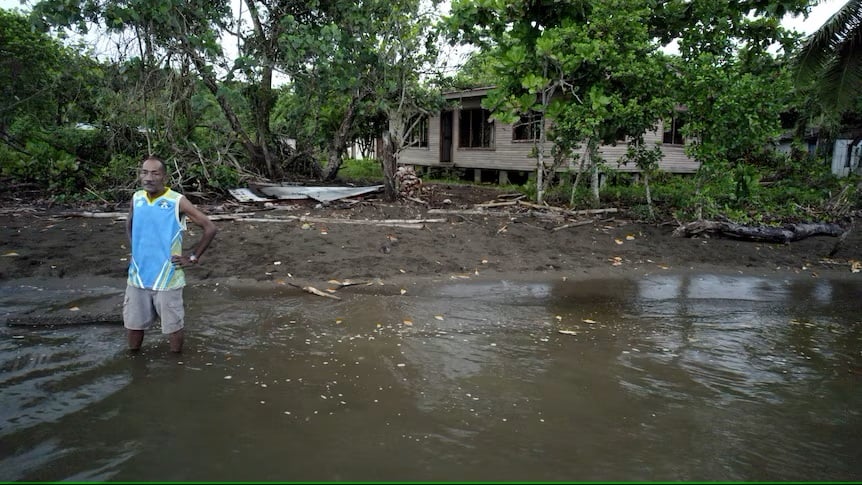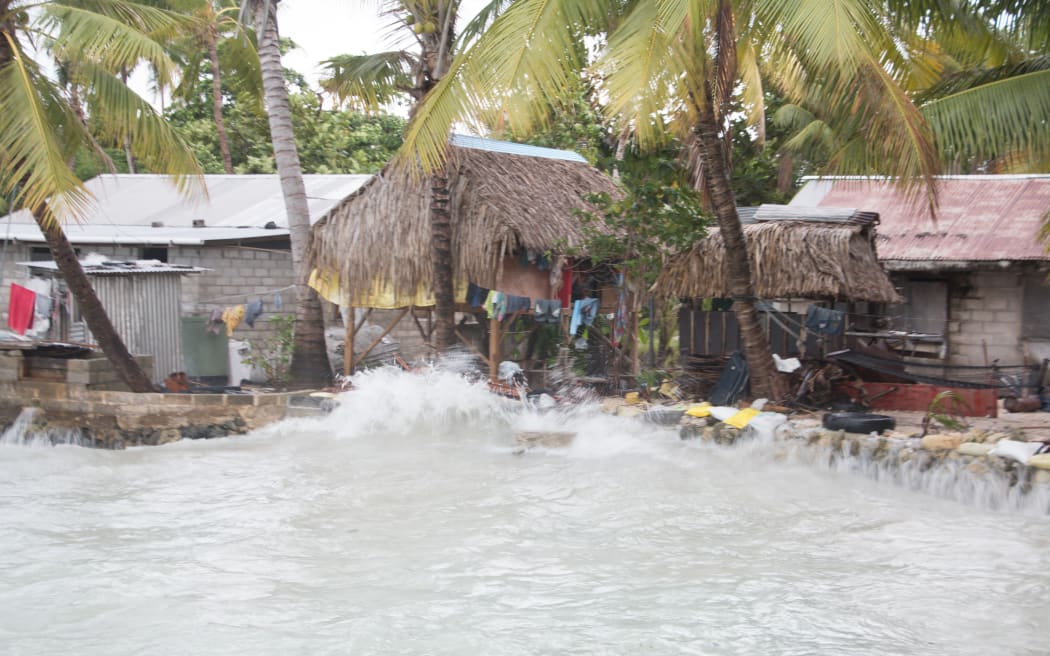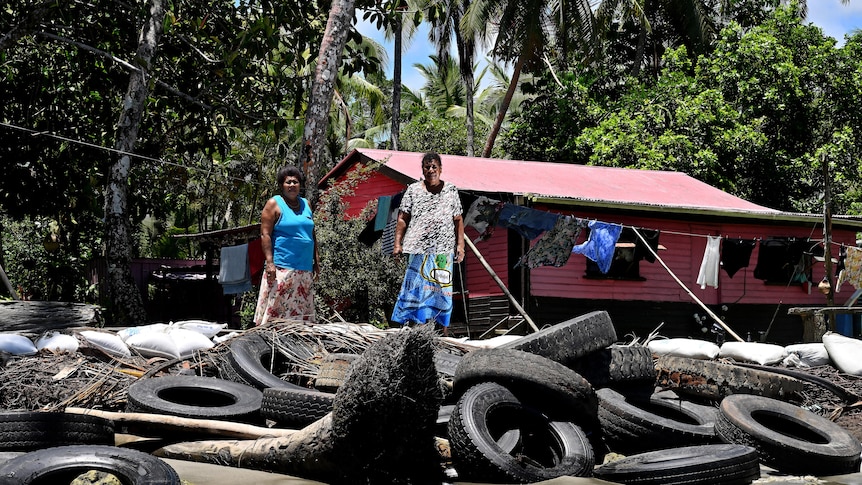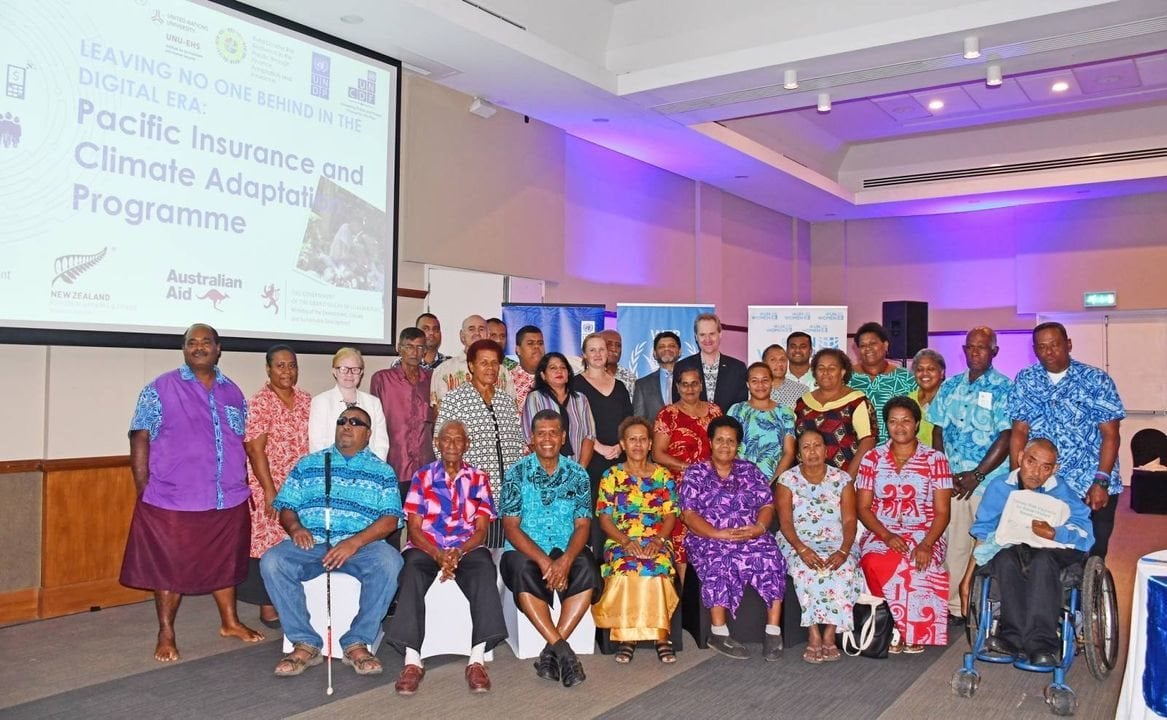Climate change has pushed Vunidogoloa on the remote shores of Fiji’s second-biggest island to be the first communities in the world forced into a government-planned relocation
As he pushed through knee-deep water, Sailosi Ramatu suddenly paused. He pointed to the stub of a post barely visible in the seabed.
“This was my house,” he said, matter-of-factly.
It stopped me in my tracks.
One minute I’d been worried about my shoes squelching as we waded along an eroded shoreline past the remnants of an abandoned village.
The next, I was feeling the extent of this man’s profound loss.
Sailosi’s village of Vunidogoloa, which once stood here on the remote shores of Fiji’s second biggest island, has the dubious honour of being one of the first communities in the world to be forced into a government-planned relocation because of climate change.
Vunidogoloa is one of six Fijian villages that have already been moved because of the impacts of climate change, and dozens more are currently being assessed for relocation.
With 20 per cent of Fiji’s population of nearly a million people living on coastal and river fringes, thousands now face the prospect of having to move to higher ground.
Relocating a village is not a simple matter of finding and forking out hundreds of thousands of dollars, although that must be done.
In Fiji, it also means severing the very spiritual connections to ancestors and to the land and seas of the territory to which they belong – the traditional bonds known as “Vanua”.
Nine years after the traumatic event, Sailosi still feels the pain.
“Because we were born here, our parents were here, leaving it behind, and going, that’s something that really hurts us,” he said, clutching at his heart.
An accelerating crisis
For many Fijians, dealing with climate change disruption is not a theoretical issue for the future, it’s an inescapable part of daily life.
And it’s not their fault. Climate change has been driven by industrial development far from Fiji.
“I think our contribution to the effects of climate change is about a drop in the ocean,” said Alani Tuivucilevu, of Fiji’s Women in Fisheries Network.
“It is frustrating, because all we do is face the consequences.”
This region is one of the globe’s climate change hotspots, where the impacts are happening at an accelerating pace.
I’d read studies showing the region has experienced a temperature rise of 0.15C degrees every decade since 1950, and a sea level rise of 4mm per year since 1993 – faster than the world average, and it’s accelerating.
So I went to see Terry Atalifo, who heads up Fiji’s Meteorological Service, which advises the government on communities at risk.
Storm surges, floods, destructive tides and landslides are among an array of soul-destroying and economy-gutting torments bearing down on Fiji more frequently than before.
Terry told me that category five cyclones – the strongest type of tropical storm – are also becoming more common.
“I think in the last 10 years, apart from two cyclone seasons, every other cyclone season we are experiencing a category five in this region,” he said.
In 2016, Fiji was struck by category five tropical cyclone Winston, which killed 44 people and cost US$1.35 billion in damage and repairs.
Since then, more cyclones of similar intensity have hit Fiji, and the price tag of these disasters is expected to multiply in coming decades.
‘All the people were crying’
Down at street level, this translates to a world of pain.
The original village of Vunidogoloa was perched on a point where a river meets the sea. It had an abundance of fish, coconuts and garden crops.
Sailosi and the rest of his community of around 150 people fought desperately to stay put as rising waters encroached further and further into their cherished village.
“I had already relocated (my house) three times … within the old village site,” he said.
Several attempts to move homes further away from the shore, and two seawalls costing thousands of dollars, were not enough to stave off the inevitable.
The first wall is well under water now, 60 metres from the current shoreline.
Heavy rain and tidal surges eroded the coastline, swamping houses with sewerage-contaminated water and poisoning the land with salt from the sea.
In 2014, the village had no choice but to move to a new site 2km uphill in a procession described as “funeral”.
“All the people were crying because it was their last day,” Sailosi recalled.
Fiji is well-advanced in planning for forced relocations.
Detailed government guidelines and procedures have been developed over the past decade to ensure an orderly and inclusive process.
But relocations are time consuming, complex and costly. The government says they should be a last resort.
Even so, 830 communities have been identified as at-risk from climate change, with the relocation of more than 40 of these currently being assessed.
The new village of Vunidogoloa has 32 houses, which together with roads and other infrastructure cost more than US$1 million.
The villagers were luckier than most. They had land they could move to without any tricky traditional ownership negotiations.
The move is considered a success. They now have the convenience of flushing toilets and piped water, and a road into town to shops, schools and health services.
For young people, there’s more freedom.
But the relocation wasn’t without mistakes either. The houses were originally built without kitchens, so people had to add their own out of materials salvaged from the old houses.
I guess that’s what happens when women are left out of the planning meetings.
The move has also seen a rise in health and social problems though, including social stresses, instances of domestic violence, increased diet of processed foods, alcohol and other issues, according to a 2021 longitudinal health study.
It found traditions and culture have also been weakened.
They’re no longer close to the sea, making it harder to go fishing, and when the homes were built they were planned around nuclear families.
Some now miss communal living with extended family under one roof, like they once had.
The chief of Vunidogoloa, Simione Botu, said moving was traumatic but at least it gave them a future.
“We have found a new place knowing that the current elders, and our children, will be living peacefully without being worried about the flooding,” he said.
Who should pay?
While the lessons from Vunidogoloa’s move will prove invaluable for other villages in Fiji, the question of who pays for the disruptions of climate change is far from settled.
Last November, at the United Nations COP27 talks, developed countries finally agreed to a “Loss and Damage” compensation fund, long sought by small island nations and developing countries for the devastating and irreversible impacts of climate change.
It’s estimated to need between US$429 billion and US$860 billion by 2030.
Questions remain over who will pay, and how much – or even if they will pay. There is no compulsion built into the agreement.
Previous funds promised for climate adaptation measures have fallen short in practice.
Meanwhile, the old people of Vunidogoloa still frequently trek the steep, muddy path to visit the old village, answering the call of the ancestors and the sea.
Their new life is only a few kilometres distant but it’s a world away from the spirits that guided them.
Standing in the shallows at the now abandoned village of Vunidogoloa, Sailosi’s voice choked with emotion when he remembered his old life.
“I was here,” he said.
He was pointing to the concrete pad where his wash room once was. But as I stood beside him, I think I understood his full meaning.
This story was written by Deborah Richards, originally published at ABC Pacific on 06 April 2023, reposted via PACNEWS.




